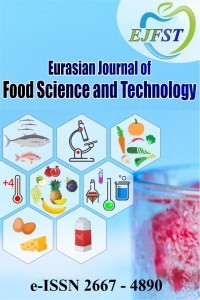The Optimization Method by Using the Transformation of Two Variable Dependent Experiment Results into Image Data and Its Usability in the Food Engineering Applications
The Optimization Method by Using the Transformation of Two Variable Dependent Experiment Results into Image Data and Its Usability in the Food Engineering Applications
___
- Aksay S. & Mazza G. 2007. Optimization of protein recovery by foam separation using response surface methodology. Journal of food engineering, 79(2), 598-606.
- Burger W.& Burge M. J. 2016. Digital image processing: an algorithmic introduction using Java. Springer.
- Buzrul S., Cevik M. & Alpas H. 2008. Comparison of response surface methodology and the proposed Weibull model for inactivation of Listeria innocua by high hydrostatic pressure. Journal of food safety,28(1), 142-156.
- Cordova C., Heidenreich B., Popolitov A. & Shakirov S. 2016. Orbifolds and Exact Solutions of Strongly-Coupled Matrix Models. arXiv preprint arXiv:1611.03142.
- GoksungurY., Mantzouridou F., Roukas T. & Kotzekidou P. 2004. Production of β-carotene from beetmolases by Blake sleatrispora in stirred-tank and bubble column reactors. Applied biochemistry and biotechnology, 112(1), 37-54.
- Ibanoglu S. & Ainsworth P. 2004. Application of response surface methodology for studying the viscosity changes during canning of tarhana, a cereal-based food. Journal of food engineering 64(3): 273-275.
- Kılıç K., Köksel H. &Boyacı İ. H. 2006. Görüntü İşleme Tekniği ve Gıda Teknolojisi Alanında Kullanımı: Deneysel Uygulamalar, Türkiye 9. Gıda Kongresi, İzzet Baysal Kültür Merkezi (pp. 39-40), Bolu.
- KoçB. & Kaymak-Ertekin F. 2009. Yanıt yüzey yöntemi ve gıda işleme uygulamaları, Gıda, 1-8 p.
- Lau T. K. & Lin K. W. 2016. U.S. Patent No. 9,307,133. Washington, DC: U.S. Patent and Trademark Office
- Russ J. C., Matey J. R., Mallinckrodt A. J.& McKay S. 1994. The image processing handbook. Computers in Physics, 8(2), 177-178.
- Saklar S., Katnas S.&Ungan S. 2001. Determination of optimum hazelnut roasting conditions. International journal of food science & technology, 36(3), 271-281.
- Samtaş G.& Gülesin M. 2012. Sayısal Görüntü İşleme ve Farklı Alanlardaki Uygulamaları. EJOVOC: Electronic Journal of Vocational Colleges, 2(1).
- Sofu M. M., Er O., Kayacan M. C.&Cetişli B. 2013. Elmaların görüntü işleme yöntemi ile sınıflandırılması ve leke tespiti. Gıda Teknolojileri Elektronik Dergisi, 8(1), 12-25.
- Ürküt Z., Daǧbaǧlı S.&Göksungur Y. 2007. Optimization of pullulan production using Ca‐alginate‐immobilized Aureobasidium pullulans by response surface methodology. Journal of chemical technology and biotechnology, 82(9), 837-846.
- Yayın Aralığı: Yılda 2 Sayı
- Başlangıç: 2017
- Yayıncı: İlknur BAĞDATLI
Gözde TÜRKÖZ BAKIRCI, Fatih ÇAKMAK
Chemical Migration from Plastic Types of Food Contact Materials
Perihan YOLCI OMEROĞLU, Tuğba ÖZDAL, Rüya BULUT
Starch Based Sugar; Production, Usage and Health Effect
Nutrition for Functionality of Poultry Meat and Egg
Determination of Table Olive and Olive Oil Consumption and Preference of Children from Yalova/Turkey
Yasin OZDEMIR, Aysun OZTURK, Seda KAYAHAN, Ozge KESKINEL
Selahaddin Batuhan AKBEN, Selin KALKAN, Demet ÇANGA
Glycerol-Based Process Contaminants in Palm Oil
